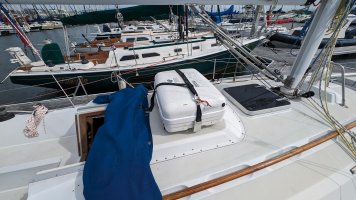On the long list of preparations for cruising the Channel Islands and Hawaii from San Francisco is the installation of a life raft. I'm not really fond of hanging it off the stern pulpit. The next logical spot is amidships on the sea hood (aka "the turtle shell", as I call it). Below is a photo of an empty life raft case and mounting bracket similar to the one I intend to use:

Luckily, I'm in the process of replacing the mainsheet traveler, which is through bolted to the sea hood. I'll have one time access to the underside of this large fiberglass shell, so I need to utilize a bolting system in which I don't have access to the underside. I'd like to make the mount removable for times when I don't need 85lbs of life saving rubber and CO2 in front of me.
I have ideas rolling around my head, like drilling holes and using epoxy to permanently mount through bolts with heavy washers on the under side of the seahood. Then when the life raft is out using round cut discs of G10 to cover the bolts.
What other ideas are out there? Or links to similar projects needing a similar technique?
Cheers and thanks!
- Bryan

Luckily, I'm in the process of replacing the mainsheet traveler, which is through bolted to the sea hood. I'll have one time access to the underside of this large fiberglass shell, so I need to utilize a bolting system in which I don't have access to the underside. I'd like to make the mount removable for times when I don't need 85lbs of life saving rubber and CO2 in front of me.
I have ideas rolling around my head, like drilling holes and using epoxy to permanently mount through bolts with heavy washers on the under side of the seahood. Then when the life raft is out using round cut discs of G10 to cover the bolts.
What other ideas are out there? Or links to similar projects needing a similar technique?
Cheers and thanks!
- Bryan
